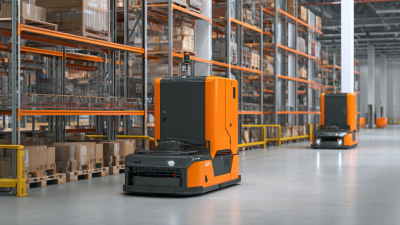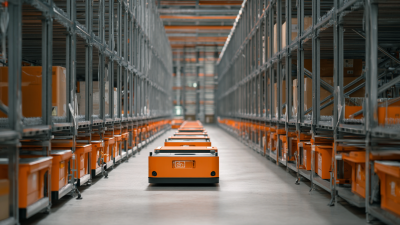Understanding the Future of Logistics with AGV AMR Technology Innovations
The logistics industry is on the brink of a technological revolution, driven by the innovations in Automated Guided Vehicles (AGV) and Autonomous Mobile Robots (AMR). As the demands for efficiency and precision in supply chain operations continue to soar, understanding how these technologies can be leveraged is paramount for businesses aiming to remain competitive. Industry expert Dr. Sarah Thompson, a leading authority in logistics automation, emphasizes the significance of this shift: "The future of logistics lies in our ability to seamlessly integrate AGV and AMR technologies into our existing operations, unlocking unprecedented efficiencies and flexibility."

In the evolving landscape of logistics, AGV and AMR systems are not merely trends but essential tools that redefine the way goods are transported and managed within warehouses and distribution centers. These innovations promise enhanced operational effectiveness, reducing labor costs and minimizing human errors. As we delve into this topic, it becomes clear that organizations must adapt to these advancements to harness their full potential, ensuring a streamlined and responsive supply chain.
This article aims to guide readers through the exciting developments in AGV and AMR technologies, exploring their applications, benefits, and future implications for the logistics sector. By understanding these technologies, businesses can prepare themselves for an innovative future where AGV and AMR play a pivotal role in transforming logistics efficiency.
The Evolution of AGV and AMR Technologies in Modern Logistics
The evolution of Automated Guided Vehicles (AGVs) and Autonomous Mobile Robots (AMRs) has significantly transformed the logistics landscape. Initially, AGVs required fixed routes and extensive infrastructure, limiting their flexibility. However, recent advancements in AMR technology have introduced capabilities such as dynamically pathfinding and real-time navigation, allowing for a seamless transition in warehouse operations.
According to a 2023 report by Grand View Research, the global AGV market is expected to reach USD 9.8 billion by 2025, while the AMR market is projected to grow at a compound annual growth rate (CAGR) of 30.5% from 2023 to 2030, underscoring the rapid adoption of these technologies.
The integration of AGV and AMR technologies is enhancing efficiency and reducing operational costs in supply chains. For example, a BlueWeave Consulting report noted that companies implementing AMR solutions witnessed a 30% decrease in labor costs and a 50% increase in overall productivity within the first year. Additionally, with the push for automation intensified by the pandemic, firms are increasingly investing in these technologies to maintain competitive advantages. As logistics demands continue to grow, the evolution of AGV and AMR technologies indicates a future where intelligent automation will redefine operational excellence in modern supply chains.
Key Innovations Driving Efficiency in Automated Logistics Solutions
The logistics industry is experiencing a paradigm shift driven by groundbreaking innovations in Automated Guided Vehicles (AGVs) and Autonomous Mobile Robots (AMRs). These technologies are revolutionizing the way goods are transported within warehouses and distribution centers, enhancing efficiency and reducing operational costs. The integration of AI in logistics is particularly noteworthy, as it allows companies to optimize supply chain management and improves decision-making processes. For instance, the implementation of agentic AI facilitates autonomous operations, significantly accelerating process efficiency and enabling logistics firms to scale their operations more effectively.
Tips: When considering AGV and AMR technologies for your logistics operations, focus on understanding your specific needs and challenges. Evaluate the potential return on investment and consider running pilot programs to test these innovations in your environment. Ensuring seamless integration with existing systems can further enhance the benefits of these technologies.
Moreover, as the logistics landscape continues to evolve, companies must adapt to the persistent push for sustainability and high-quality development. The future of logistics is not only about speed and efficiency but also about responsible and innovative practices that contribute positively to the environment. Embracing AI-powered solutions alongside AGV and AMR technologies will be crucial for organizations aiming to thrive in this competitive landscape.
The Role of AI and Machine Learning in Enhancing AGV and AMR Systems
The integration of AI and machine learning into Automated Guided Vehicles (AGVs) and Autonomous Mobile Robots (AMRs) is transforming the logistics landscape. According to a recent report by Allied Market Research, the global AGV market is projected to reach $12.8 billion by 2027, driven largely by innovations in AI. These technologies enable AGVs and AMRs to analyze large datasets in real time, improving route optimization and warehouse management. This dynamic capability enhances efficiency, reducing operational costs by up to 30% while increasing throughput.
Tips for businesses looking to implement AGV and AMR systems include starting with a clear understanding of workflow requirements and data architecture. It is essential to gather baseline performance metrics to gauge the improvement post-implementation. Regular training for staff on operating alongside these robotic systems can also ensure smooth integration. Furthermore, leveraging AI’s predictive analytics can help preempt issues related to logistics, further refining operational efficiency.
Moreover, machine learning algorithms can enable AGVs and AMRs to learn from their environment, allowing them to adapt to changes in real time. This agility reduces dependency on human oversight and can significantly cut down cycle times in operations. By investing in these technologies, logistics companies can not only enhance their productivity but also position themselves strategically for future innovations in the industry.
Understanding the Future of Logistics with AGV and AMR Technology Innovations
This chart illustrates the growth in deployment of AGVs and AMRs in logistics over the past few years, highlighting the advancements in AI and machine learning technologies that enhance these systems.
Challenges and Solutions in Implementing AGV and AMR Technologies
The integration of Automated Guided Vehicles (AGVs) and Autonomous Mobile Robots (AMRs) into logistics operations presents a range of challenges that organizations must navigate. One of the primary obstacles is the complexity of technology integration with existing systems. Many companies rely on legacy infrastructure, which can complicate the deployment of AGV and AMR solutions. To address this, organizations may need to invest in comprehensive training programs to ensure employees can effectively use and maintain the new systems, along with seeking expert consultation for seamless integration.
Another notable challenge is the significant upfront investment required for AGV and AMR technologies. While the long-term benefits include increased efficiency and reduced labor costs, the initial financial outlay can deter smaller companies from adopting these innovations. To mitigate this issue, companies should consider phased implementation strategies or leasing options that allow them to gradually adopt the technology while assessing its impact on their operations. Additionally, clear communication about the expected ROI can help secure buy-in from stakeholders and facilitate smoother transitions into automated logistics solutions.
Future Trends and Predictions for Logistics Automation with AGV and AMR
The future of logistics is being dramatically shaped by innovations in Automated Guided Vehicles (AGVs) and Autonomous Mobile Robots (AMRs). As businesses increasingly seek efficiency and cost-effectiveness, the adoption of these technologies is on the rise. One significant trend is the integration of advanced artificial intelligence and machine learning algorithms into logistics operations. This advancement allows AGVs and AMRs to dynamically adapt to changes in their environment, optimize routes, and enhance overall productivity without the need for extensive human intervention.
Another key prediction for the future of logistics automation is the growth of collaborative robotics. As AGVs and AMRs become more integrated into warehouse and distribution center operations, their ability to work alongside human workers will improve. This collaboration is expected to not only increase efficiency but also enhance workplace safety. Furthermore, with ongoing advancements in battery technology and charging infrastructure, the operational uptime of these machines will be maximized, enabling more seamless logistics processes. As companies leverage these innovations, we can anticipate a significant transformation in supply chain efficiency and responsiveness.
Related Posts
-

Enhancing Warehouse Efficiency: The Impact of AGV Systems on Operational Costs and Throughput
-

Exploring the Future: Unconventional Robotics Careers You Never Knew Existed
-

Understanding the Importance of Robot Safety in Modern Automation
-

Understanding the Future of Logistics with Advanced AGV Systems in Modern Warehousing